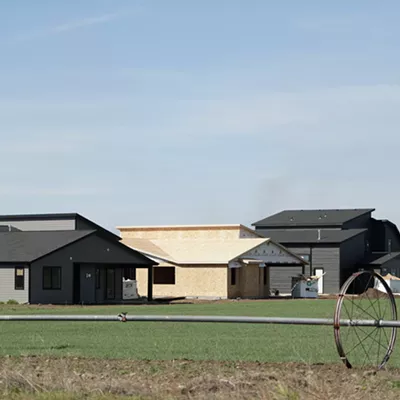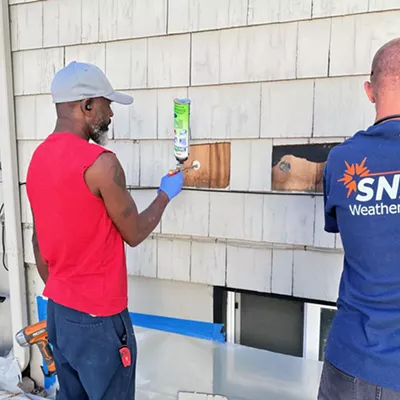No More Moore -- Seeing Michael Moore in The Inlander's Fall Arts Preview issue (9/11/03) finally irritated me enough to write this letter.
Michael Moore snookered Oprah into believing that a bank just presented him with a rifle (as he demonstrated in his movie, Bowling for Columbine), is a bunch of BULL. Michael Moore had to deposit a certain amount of dollars for a certain number of years.
Usually, it's $2,000 to $5,000 for five to 10 years, depending on arrangements. The interest pays off the rifle. It's just more of his half-truths that anti-gunners and the gullible eat up.
John Williamson
Spokane, Wash.
Inflation "Shocks and Awes" -- I am the youngest of what is called "The Greatest Generation," and one of the millions who, rather than returning to my job as a gas meter reader, gained a college education by virtue of WWII military service. Over 95 percent of us had thought this economically impossible.
I recently found my Statement of Earnings from Bank of America for December 1964 and can't believe how it compares to today's economic environment.
As a "senior" project manager in computer systems development, my salary was a very respectable $780 a month (equivalent of $100,000 a year today). I had already exceeded the $4,800 annual maximum for FICA deduction (social security - no Medicare). For income taxes, $78 was withheld, and $7.40 provided full medical and hospitalization/surgical coverage for my family of five!
Our 10-year old, 1,100-square-foot, three-bedroom, single-bath home, with payments of $125 a month, in a subdivision of several hundred similar homes 25 miles east of San Francisco, had risen from its $8,900 original price to about $16,000 in market value (the same house today is worth $200,000).
We drove a two-year-old Buick four-door that was paid for. Gasoline was under 25 cents a gallon; our children walked less than half a mile to school. I commuted by Greyhound bus to San Francisco for $14 a month. Flying business class between San Francisco and Los Angeles was less than $20 each way, and "good" motel rooms were $7.50 per day.
We lived comfortably on my income in 1964, something many families cannot do today with two incomes. Rampant inflation since the early 1970s and the skyrocketing cost of living have offset the higher incomes today compared to 40 years ago.
William H. Allison
Medical Lake, Wash.
Sell Plaza, Sell Out -- Disheartening is too mild a word for feelings when reading about the obsession among Spokane's elite to sell the Spokane Transit Plaza facility. Not long after first moving to Spokane three years ago, I decided to use the bus to travel from South Hill to downtown for some on-foot exploration. When I arrived at the Plaza, it seemed immediately obvious that this is a community, not an "Empire" (as local media strangely describe it). It's a community with a priority for treating its non-wealthy residents as valued members of the social order, and a community that wants everyone, even the upper classes, to value the environmental and economic attributes of a healthy mass transit system.
The Plaza's atmosphere isn't one of an "underclass" experience, but, rather, like that of a well-maintained airport. The skywalks connecting it to downtown attractions like River Park Square only enhance that. Critics who slam the Plaza as some sort of Taj Mahal wouldn't for a split second describe Spokane International Airport that way. Sure, if you look for them, you can find impoverished residents at the Plaza, but even those with the very least seem to have respect for the quality of the facility and for its employees who are there to serve them. It just always feels comfortable to be there. That comfort level led to me becoming a regular transit rider, something I never was in any of the other western cities where I've lived. I've even taken visitors from out-of-state to the Plaza, demonstrating that Spokane understands a key quality-of-life measure: the treatment of those who have the least. I'm hopeful that Spokane's penny-wise/pound-foolish, bottom-line-driven elite will come to recognize that the cultural loss from the Plaza's sale would never be offset by money it would generate. I'm sure many would pay $1 or $2 more for monthly passes to prevent that sale.
Robert A. Ethington
Spokane, Wash.
Southern Site in Sights -- For all the reasons listed in the article "Wrong Direction" (9/18/03), the southern site for the Convention Center is better. I wrote to the Planning and Facilities District (PFD), early in the planning process recommending the southern site. It was upsetting when I heard they chose the eastern one. I believe it looks good on paper, but we all know that what looks good in numbers isn't always the best solution. If I was Walt Worthy or another major contributor to downtown's revival, I'd be deeply disappointed.
But I have a solution. Glen Cloninger owns some of the southern property (considered for use in the Convention Center expansion) and has announced an interest in building a tower, with the most valuable part being skyward. The city only wants the ground floor for the convention center. Let's demonstrate that city and business can work together by creating a win-win solution with each party getting what's most valuable to them. The city gets the ground floor, and Mr. Cloninger takes the sky above. There is a common interest here, and we need be bold and creative enough to seize it.
James Jarvis
Spokane, Wash.
Publication date: 10/02/03
















